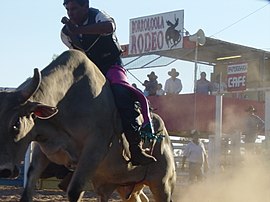Borroloola, Northern Territory
|
Borroloola Northern Territory |
|||||||
|---|---|---|---|---|---|---|---|

The Borroloola rodeo is held in August each year
|
|||||||
| Coordinates | 16°04′13″S 136°18′26″E / 16.07028°S 136.30722°ECoordinates: 16°04′13″S 136°18′26″E / 16.07028°S 136.30722°E | ||||||
| Population | 926 (2011 census) | ||||||
| Postcode(s) | 0854 | ||||||
| Elevation | 17 m (56 ft) | ||||||
| Location |
|
||||||
| LGA(s) | Roper Gulf Region | ||||||
| Territory electorate(s) | Barkly | ||||||
| Federal Division(s) | Lingiari | ||||||
|
|||||||
Borroloola is a town in the Northern Territory of Australia. It is located on the McArthur River, about 50 km upstream from the Gulf of Carpentaria. At the 2011 census, Borroloola had a population of 926.
Borroloola lies on the traditional country of the Yanyuwa people, on the coastal plain between the Barkly Tablelands and the Gulf of Carpentaria. Rivers that run from the Tablelands escarpment to the Gulf regularly flood in the wet season, making travel on the unsealed section of Highway One along the coastal plain to Queensland impossible. The rivers of this region have carved spectacular gorges through sandstone deposits in their upper reaches. The rivers and coastal areas are host to barramundi, earning Borroloola a reputation among sports fisherman, and also to the deadly saltwater crocodile. The region has little rain from May to September, and is characterised by lightly treed Savanna grasslands.
The 'Coast Track' follows the path of cattle drovers of the late 19th century as they moved herds from north-west Queensland to stock the new stations of the Northern Territory and the Kimberley. The drovers in turn followed a well-worn Aboriginal path. Tony Roberts (2005) writes a moving and well-researched history of the region, in which the local tribes went from almost total isolation from European Australians in 1870, to a decimated collection of displaced and defeated groups, over a single decade. Entire tribes such as the Wilangarra, including women, children and babies were massacred, and most adult males were killed, by police and quasi-police groups, and by drovers and station workers involved in the cattle droves of that era.
...
Wikipedia

